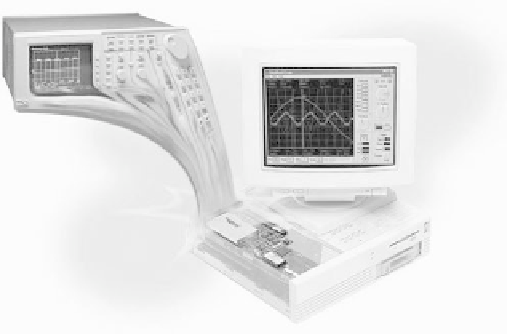Biomedical Engineering Reference
In-Depth Information
Finally, several clinical research applications of VI are
described.
Case study #1: a real-time bed-
management and census-control
dashboard
The problem
Most health care institutions today manage patient flow
via paper, whiteboards, and phone calls. As a result,
hospitals often lack precise and timely information to
match bed availability with patients' clinical needs. This
causes inefficient use of beds, resources, and provider
time, which leads ultimately to reduced throughput;
emergency department (ED) overcrowding; lost ad-
missions; operating room (OR) delays; unhappy physi-
cians, staff, and patients; decreased revenue; and higher
expenses.
Figure 5.5-1 VI: Replicating and enhancing traditional ''vendor-
defined'' instruments with virtual ''user-defined'' instruments.
(Courtesy of National Instruments.)
biomedical applications and executive information tools.
These applications fall into several categories, including
process improvement, decision support, and clinical re-
search. The following case studies are intended to illus-
trate the myriad of applications that are possible with
this powerful technology.
Industry trends
Concerns over patient access to hospital care are quickly
becoming the largest, most urgent health care issue on
the public's agenda. Many hospitals are now struggling to
cope with surprising increase in the numbers of patients.
Nationwide, hospitals report unprecedented inpatient
and outpatient volumes, while average occupancy levels
approaching 100% are not uncommon. These problems
are compounded by two nationwide trends in hospitals:
(1) increase in the numbers of patients; and (2) decrease
in the numbers of beds.
Some hospitals are being forced to turn away ambu-
lances and to cancel or delay elective surgeries because of
a shortage of hospital beds. At other hospitals, ED pa-
tients wait hours, or even days, for rooms. Administra-
tion has no information to be able to match proactively
the demand for patients with the appropriate level of
nurse staffing. In addition, aging baby boomers are more
likely to experience serious illness or injury, and medical
advances are helping doctors to treat conditions that
patients simply might have accepted in the past. There is
an overall staff shortage of hospital workers, especially
among nurses. With no sign of slowdown in these trends,
these problems in hospital care appear set to escalate for
the foreseeable future (
AHA, 2001
).
The lab VIEW development environment
For many of its VI solutions discussed in this chapter,
an application development environment (ADE) called
LabVIEW has been used. LabVIEW was created by
National Instruments (Austin, TX). It is an off-the-
shelf graphical development environment designed
specifically for developing integrated measurement and
automation systems. Developers assemble user in-
terfaces and high-level functions for data acquisition
and control, signal processing and analysis, and visuali-
zation, in the same way that flowcharts are constructed.
With the modularity and hierarchical structure of
LabVIEW, users can quickly and easily prototype,
design, deploy, and modify systems. The LabVIEW
ADE is compiled for maximum execution performance,
contains hundreds of advanced analysis routines, and
allows developers to quickly design and build advanced
applications.
This chapter presents several ''real-world'' virtual
instrument applications and tools that have been de-
veloped to meet the specific needs of health care or-
ganizations. Particular attention is placed on the use of
quality control and ''performance indicators,'' which
provide the ability to trend and forecast various metrics
and improve processes. The use of SPC and modeling
within virtual
The solution
The Bed Management Dashboard (BMD) is a real-time
process improvement and decision support product used
by hospital administrators, clinicians, and managers on
instruments
is being demonstrated.









